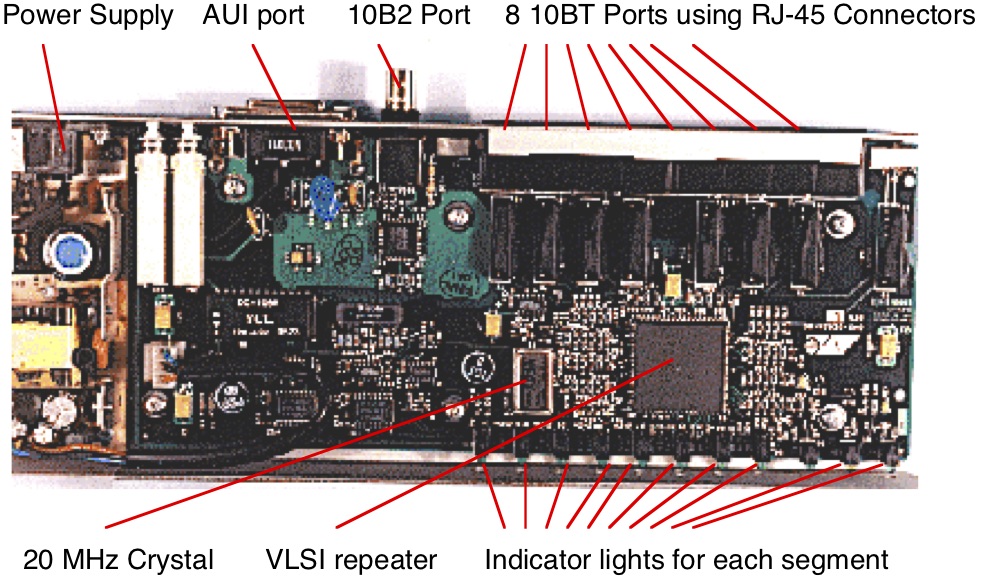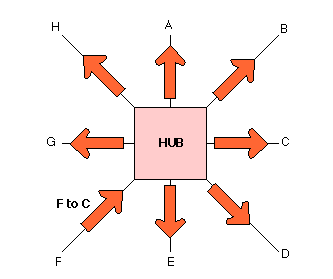
Ethernet hubs and repeaters operate at the Physical Layer and are defined by IEEE 802.3c/d. They are used to connect together one or more Ethernet cable segments of any media type operating at the same speed.
Ethernet repeaters overcomes the constraint of the maximum cable segment length. If an Ethernet segment were allowed to exceed the maximum length or the maximum number of attached systems to the segment, the signal quality would deteriorate. (If unchecked this would ultimately lead to errors in the data.)
Hubs and repeaters may be used between a pair of segments (see below) to provide signal amplification and signal regeneration, whcihs restores a good signal before sending the signal to another cable segment. By allowing two or more LAN segments to be connected, they allow the network to span a larger distance.
They also provide electrical isolation from failures in the cable or attached systems, protecting equipment on other LAN segments from the effect of the fault.

A key fact about hubs and repeaters is that they allow users to share an Ethernet LAN. A network of repeaters and hubs is therefore called a "Shared Ethernet" or a "Collision Domain". The various systems sharing the Ethernet all compete for access using the CSMA/CD access protocol. This means that only one system is allowed to proceed with a transmission of a frame within a Collision Domain at any one time. Each system has to share a proportion of the available network capacity.
A network of repeaters and hubs is therefore called a "Shared Ethernet" or a "Collision Domain".
The DPLL in the transceiver can not always lock on to the start of a frame's preamble. Usually this takes a number of bit periods for a receiver to completely synchonise with the Manchester Encoded data. An important job of a repeater is therefore to reconstruct this preamble before it sends the signal to the next cable segment. For example, consider a frame sent by X (above). This frame will be received by the computer Y and the repeater. In each case, the first part of the preamble will be lost, since the transceiver will not have acquired lock on to the Manchester Encoded clock signal. If the shortened preamble were to be sent on to computer Z, it could be insufficient to allow Z to acquire a lock before the start of the frame. A repeater must therefore reconstruct the full preamble before a frame is sent out of the repeater.
An Ethernet LAN may transport parts of a frame (e.g. as a result of a collision), any under-sized frame is known as a Runt. A repeater must extend any very short bit sequences (less than 96 bits) to ensure that they are seen by all computers on the LAN, this ensures proper operation.
Note that since a repeater is responsible for changing the bit timing, and may introduce additional bits, as above, it can not guarantee that the Inter-Frame Gap (IFG) generated by the sender is preserved in all cases. It should however not reduce this below 47 bit times.
If a repeater sees a collision on a cable segment, the repeater detects this (in the normal way), and then generates a JAM signal to all connected output ports. This ensures that every computer connected to the LAN is aware of the collision, and does not try to transmit during the collision period.
Hubs are a form of repeater for an Ethernet LAN which has multiple ports (they are sometimes also known as "multi-port repeaters" or "active star networks").

Each port of a hub has an RJ-45 connector able to accept a patch cable to connect to a wall outlet. The other end of the cable is normally connected to a network interface card with a 10BT outlet. Many hubs also have an AUI connector which may be used to connect an external transceiver to which other types of Ethernet Media may be attached. (Sometimes a 10B2 connector is also provided to allow connection directly to a coaxial cable thin Ethernet network.) Whatever the type of connector, a single hub is a only able to connect a group of equipments operating at the same speed (i.e. all equipment connected to a 10BT hub must operate at 10 Mbps).

Each port (or interface) allows one piece of equipment to be connected to the hub. In this case the system connected via the port F is sending a frame of data to the system connected at port C. The hub is not able to recognise the addresses in the header of a frame,and therefore is unable to identify which port to send to. Therefore, every frame is sent to every output port. (This is in contrast to a bridge, switch or router, each of which only forwards a packet if the destination address of the packet corresponds to a system reachable via the output interface.)
Example of an office hub. Larger hubs could be used to connect larger groups of users.
Any repeater or hub may optionally monitor the number of collisions which it observes from each port. If the number rises above a threshold, the repeater / hub may then disable the port (sometimes called a "partition").
A hub may also monitor the state of the transceiver at each 10BT and 10BF Ethernet port. On these interfaces, nodes send a unique signal every 16 +/- 8 ms. This signal is called an "idle pulse". Receivers monitor the medium to check that idle pulses are received. If neither an Ethernet frame, or an idle pulse is received within 50-150 ms, the receiver may assume that the cable is not functioning correctly. A hub may then disable the port (sometimes called "partition").
A disabled port is made active again when 2-10 valid idle pulses are received. This can protect other correctly operating ports from the disruption caused by a faulty NIC, transceiver or hub. The idle pulse is also used in some pieces of equipment to automatically detect the speed of transmission (10 or 100 Mbps) and availability of the full duplex mode.
See also: